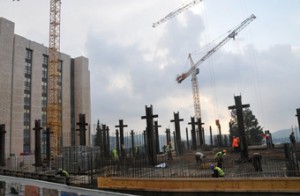Health + Medicine
Feature
Medicine: Hospitals in Hard Times

Whether you call it financial slowdown or economic meltdown, whether you believe we are still in freefall or inching toward recovery, what is beyond argument is that we’re living through the worst global recession since World War II. a Little has escaped the financial turbulence of the past two years, but hospitals have been uniquely vulnerable. They regularly lay out large sums on facilities and medical equipment, while their cash flow (much of it in the form of delayed payments from health insurance companies) is not always predictable.
The Hadassah-Hebrew University Medical Center in Jerusalem is not only weathering the economic storm that is blasting hospitals around the globe, but it has also been hit by an additional triple whammy.
First, little noticed in the United States but unpleasantly apparent in Israel, was the devaluation of the dollar. With $50 million to $80 million coming to the medical center from Hadassah, the Women’s Zionist Organization of America, for development each year, this has had a catastrophic impact.
The second hit was the plummeting of the international money markets, which went into high gear with the collapse of Lehman Brothers in September 2008 and had a negative impact on donors and investments. And hard on its heels came the disintegration of Bernard Madoff’s investment scheme, losing Hadassah millions.
“This was the context within which we had to decide how to lead our medical center through tough times,” says Dr. Shlomo Mor-Yosef, director-general of the Hadassah Medical Organization. “The main challenge was to decide…what we must do now and what we can postpone, so that our hospitals continue functioning as well or better than ever, and continue to develop and to lead.”
The medical center’s leadership started by taking a look at its resources. With its supporters—Hadassah, Israel’s government and the Hebrew University of Jerusalem—all hurting financially, it was immediately clear that expenses must be massively reduced.
Salaries were where the ax first fell. With the medical center one of only a handful of privately owned hospitals in Israel (most belong either to the government or to the General Health Fund), its salary structure is outside the national collective hospital wages agreement. An across-the-board salary cut needed the agreement of Hadassah’s three unions.
Before approaching the unions, however, top management salaries were slashed by 3 to 5 percent and a number of senior management positions were cut. Dr. Mor-Yosef took the largest salary reduction himself. Then the unions of the physicians, nurses and workers were asked to lower costs for a two-year period—with the acknowledgment that all reductions were effectively a loan to be returned once the hospital’s financial situation stabilized.
“We opened the medical center’s books to the union heads and showed them all the figures,” says Dr. Mor-Yosef. “Mid-February 2009, within six weeks of opening discussions with them, we had signed agreements with all three unions to cut salaries and benefits. These agreements yield an annual savings of [$20 million].”
At the same time, all current medical center building projects came under scrutiny. A first and easily reached decision was to ensure completion—on schedule—of the Sarah Wetsman Davidson inpatient tower.
“There wasn’t a single dissenting voice, even though this is an enormously ambitious and costly project,” says Dr. Mor-Yosef. “Our tower campaign slogan—that we’re not waiting for the future, we’re building it—has the ring of truth. Not only does Hadassah urgently need this facility, but by building it, even in times like these, we’re sending an unmistakable message to those who work here, to our patients…and to those who support the medical center worldwide, that Hadassah is here to stay….”
Though the tower’s completion on time is assured, it has not escaped undisturbed. The original plan was that all departments would relocate to the tower immediately after opening; this is no longer the case. The move is now being staggered, with priorities drawn up for the inside of the building. Initially, 200 of its 500 beds will be ready and several stories will go into full operation.
While the tower construction surges ahead, with crews working around the clock six days a week, smaller projects are on hold. The long-scheduled renovations of Hadassah’s critically overcrowded eye clinic and breast center, for example, have been halted. Both will now wait for designated gifts. Investment in certain research projects has been cut as delicately as possible. In all, savings in equipment, smaller building projects and research have reduced the medical center’s annual budget by $25 million.
At the same time, a medical center cannot stand still. Even as HMO takes a look at its operations and cash management, shrinking expenses wherever possible, it is nonetheless introducing new technologies and hiring new clinical leaders. The Middle East’s first Da Vinci® Surgical System, a remote-control robotic tool, has been purchased and Hadassah surgeons are being trained in its use. Equipment has been bought that enables Hadassah’s interventional cardiologists to perform catheter-based aortic valve replacement, sparing frail, elderly patients open-heart surgery—making Hadassah one of the few facilities worldwide with this capability. Liver-transplant surgeon Hadar Mervav, formerly of the Texas Liver Center in Houston, has joined the Hadassah team, as have Harvard Medical School radiologist Nahum Goldberg and senior pediatric cardiologist Amiram Nir.
“Some of the decisions…have been very hard indeed, but the rule of thumb has been very clear,” says Dr. Mor-Yosef. “Cuts must be made only in what has minimal effect on long-term planning. They must enable us to ride out the downturn, without any reduction in our standards, until the economy recovers and…until fund-raising, on which we heavily depend, recovers.”
“The world has been turned upside down,” Hadassah national president Nancy Falchuk told The Jerusalem Post earlier this year. “But out of every crisis rises an opportunity, and I truly believe that when the dust settles, we’ll be an organization that has stayed true to its core mission.” H










 Facebook
Facebook Instagram
Instagram Twitter
Twitter
Leave a Reply